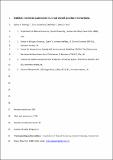Files in this item
Habitat mediates coevolved but not novel species interactions
Item metadata
| dc.contributor.author | Twining, Joshua P. | |
| dc.contributor.author | Sutherland, Chris | |
| dc.contributor.author | Reid, Neil | |
| dc.contributor.author | Tosh, David G. | |
| dc.date.accessioned | 2022-05-12T15:30:15Z | |
| dc.date.available | 2022-05-12T15:30:15Z | |
| dc.date.issued | 2022-01-12 | |
| dc.identifier | 277508086 | |
| dc.identifier | bdab9929-b91d-4e84-b263-5dcf7713ba29 | |
| dc.identifier | 85123461040 | |
| dc.identifier | 000741311300006 | |
| dc.identifier.citation | Twining , J P , Sutherland , C , Reid , N & Tosh , D G 2022 , ' Habitat mediates coevolved but not novel species interactions ' , Proceedings of the Royal Society B: Biological Sciences , vol. 289 , no. 1966 , 20212338 . https://doi.org/10.1098/rspb.2021.2338 | en |
| dc.identifier.issn | 0962-8452 | |
| dc.identifier.other | RIS: urn:8A31D0EE5CBAAB511901323C9A31F7CA | |
| dc.identifier.other | ORCID: /0000-0003-2073-1751/work/106838425 | |
| dc.identifier.uri | https://hdl.handle.net/10023/25355 | |
| dc.description | This work was supported by the British Ecological Society (SR20/1285). | en |
| dc.description.abstract | Ongoing recovery of native predators has the potential to alter species interactions, with community and ecosystem wide implications. We estimated the co-occurrence of three species of conservation and management interest from a multi-species citizen science camera trap survey. We demonstrate fundamental differences in novel and coevolved predator–prey interactions that are mediated by habitat. Specifically, we demonstrate that anthropogenic habitat modification had no influence on the expansion of the recovering native pine marten in Ireland, nor does it affect the predator's suppressive influence on an invasive prey species, the grey squirrel. By contrast, the direction of the interaction between the pine marten and a native prey species, the red squirrel, is dependent on habitat. Pine martens had a positive influence on red squirrel occurrence at a landscape scale, especially in native broadleaf woodlands. However, in areas dominated by non-native conifer plantations, the pine marten reduced red squirrel occurrence. These findings suggest that following the recovery of a native predator, the benefits of competitive release are spatially structured and habitat-specific. The potential for past and future landscape modification to alter established interactions between predators and prey has global implications in the context of the ongoing recovery of predator populations in human-modified landscapes. | |
| dc.format.extent | 9 | |
| dc.format.extent | 723684 | |
| dc.language.iso | eng | |
| dc.relation.ispartof | Proceedings of the Royal Society B: Biological Sciences | en |
| dc.subject | Habitat complexity | en |
| dc.subject | Interspecific interactions | en |
| dc.subject | Occupancy | en |
| dc.subject | Native predator | en |
| dc.subject | Invasive species | en |
| dc.subject | Multi-species models | en |
| dc.subject | QH301 Biology | en |
| dc.subject | DAS | en |
| dc.subject | AC | en |
| dc.subject.lcc | QH301 | en |
| dc.title | Habitat mediates coevolved but not novel species interactions | en |
| dc.type | Journal article | en |
| dc.contributor.institution | University of St Andrews. Statistics | en |
| dc.contributor.institution | University of St Andrews. Centre for Research into Ecological & Environmental Modelling | en |
| dc.identifier.doi | 10.1098/rspb.2021.2338 | |
| dc.description.status | Peer reviewed | en |
This item appears in the following Collection(s)
Items in the St Andrews Research Repository are protected by copyright, with all rights reserved, unless otherwise indicated.

